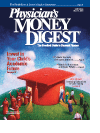Doctors Must Play for the Points
I n this day and age of anemic stock market returns, just a little return can make all the difference in the world. Physician-investors must realize that a single extra percentage point of yield can have a big effect on your retirement fund. The more money you have in the fund and the further away you are from retirement, the bigger the impact of even 1% of additional growth.
As a busy doctor, you have only so many hours in a month to keep track of your investments. For you, it makes more sense to spend the time tweaking your retirement money for an extra percentage point or 2 of yield. The benefits can be huge.
Suppose you are age 45 and have $100,000 in your retirement fund, earning an average of 8% a year. If you retire at age 60, your nest egg will have grown to just over $317,000. But now suppose you came up with a better mix of investments that averaged 9% a year. By retirement, you'd have an extra $47,000 in your account.
If you pushed for a 10% annual return (the historical long-term average for stocks), you would have an additional $100,000 in the fund, thus pushing the total close to $418,000. That extra $100,000 in the fund represents the value of the original investment and close to a 32% increase over your return at 8%.
For a 35-year-old physician planning to retire in 25 years, the impact of an additional point of yield is more dramatic. Over 25 years, a 9% return will give you an extra $177,461 in profits on a $100,000 investment that usually returns 8%. A 10% return on the same portfolio would garner almost $400,000 more in your retirement fund (see chart).
GOING FOR THE POINTS
How do you put together a portfolio with a 1% or 2% higher return than you're getting now? Money that is currently in CDs or money market accounts can be rolled over into US Treasury notes or intermediate US Treasury bonds to generate an increased return—and there's no added risk.
That brings up the subject of risk. The market axiom that greater rewards come with greater risks is certainly true, but you have to look at that maxim closely. Although stocks are a risky investment in the short term, over the long run they have proved to be solid, inflation-beating investments.
GOT THE POINT?
The longer your outlook, the more sense it makes to enjoy the historically higher yields that a stock-heavy portfolio can give you. If your time horizon to retirement is more than 10 years, it pays to go for as much yield as your tolerance for risk allows. For an investor with a 10-year outlook to retirement, a mix of 80% stocks/20% bonds is a relatively sound portfolio that gives you the greatest chance to improve your annual yield.
